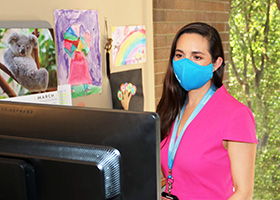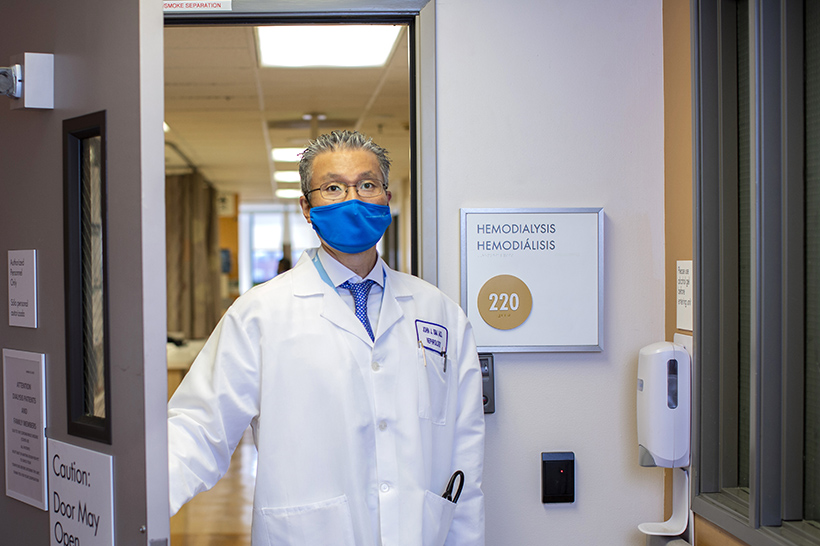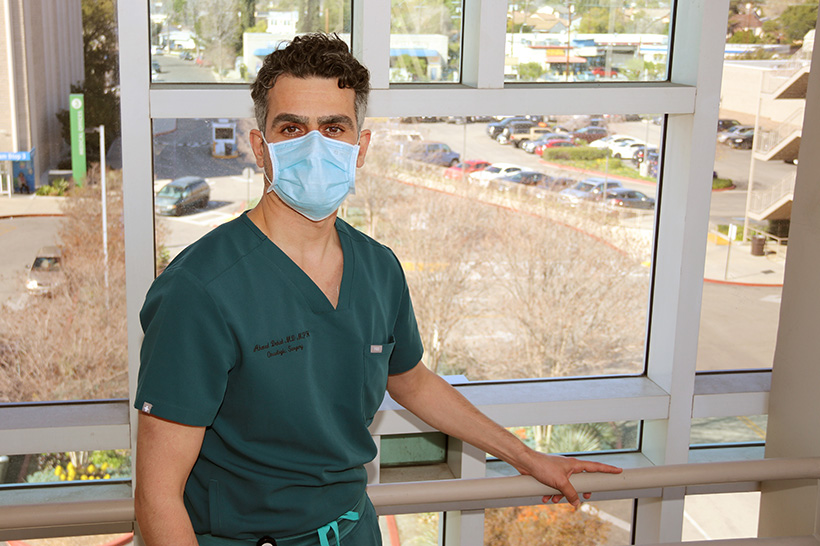Feature story:
Researchers and physicians quickly galvanize to determine who is most at risk from COVID-19
As the COVID-19 pandemic emerged, swelled, and consumed Southern California, researchers and physicians at Kaiser Permanente Southern California quickly mobilized to determine who was at the most risk and how to better protect them. Their work made headlines in major publications such as The New York Times and helped clinicians determine who needed the most focus at a time when resources were limited.
 One of the first studies from the Department of Research & Evaluation to garner national attention was led by epidemiologist Sara Tartof, PhD, MPH. Published in Annals of Internal Medicine, the research showed that obesity was associated with a substantially increased risk of death from COVID-19. However, the risk of death from COVID-19 associated with obesity was not uniform, but instead disproportionately affected men and people under 60 years of age.
One of the first studies from the Department of Research & Evaluation to garner national attention was led by epidemiologist Sara Tartof, PhD, MPH. Published in Annals of Internal Medicine, the research showed that obesity was associated with a substantially increased risk of death from COVID-19. However, the risk of death from COVID-19 associated with obesity was not uniform, but instead disproportionately affected men and people under 60 years of age.
Researchers looked at the electronic health records of nearly 7,000 Kaiser Permanente Southern California members who tested positive for COVID-19 between February 13 and May 2, 2020. Patients with severe obesity had nearly 3 times the risk of death and those with extreme obesity had over 4 times the risk of death from COVID-19 compared to those of normal weight. (A body mass index, or BMI, of 30 to 39 is considered obese, 40 to 44 is severely obese, and 45 or higher is extremely obese.)
The study also found a difference between the risk of obesity in gender: Men with severe or extreme obesity had a very high risk of death, while women had no increased risk of death associated with obesity. Also, people of Black or Latinx race/ethnicity did not have an increased risk of death from COVID-19 based on their race/ethnicity alone.
Sameer B. Murali, MD, an internal medicine physician at the Kaiser Permanente Fontana Medical Center and senior author on this study, noted that the data showed that the mortality risk of severe obesity eclipsed 11 out of 12 other medical conditions that were included in their research model.
“This observation goes beyond merely improving our understanding of COVID-19,” Dr. Murali said. “It clearly demonstrates that obesity is just as dangerous a disease condition as heart disease, kidney failure, COPD, diabetes, and others, and like COVID-19, it requires a more comprehensive response from all sectors of our society.”
People on dialysis have higher risk from COVID-19
Physicians and researchers knew that patients with end-stage kidney disease on dialysis might be at higher risk of poor outcomes from COVID-19. However, there was some hope that they might avoid the cytokine storm—the body’s immune response to COVID-19 that can have devastating effects—because of their immunocompromised condition.
The study, published in Kidney Medicine, found that these patients had 18 times higher risk of hospitalization and death from COVID-19 than people who do not have end-stage kidney disease. The lead researcher on the study was John J. Sim, MD, who is a clinician researcher with the Department of Research & Evaluation, and a nephrologist with the Kaiser Permanente Los Angeles Medical Center.

“This study raises awareness and stresses the deadly consequences for people on dialysis,” Dr. Sim said. “It also made clear the need for these patients to be even more careful about taking COVID precautions.”
Among 7,533 patients with end-stage kidney disease, 133 (16 peritoneal and 117 hemodialysis) patients were diagnosed with COVID-19 between March 1 and June 30, 2020. Researchers found that patients with end-stage kidney disease who contracted COVID-19 had a much higher mortality rate than other Kaiser Permanente Southern California members with COVID-19 (23% vs. 1.3%). There appeared to be no differences in mortality by race/ethnicity and socioeconomic status.
The study prompted discussion about prioritizing COVID-19 vaccinations for patients with end-stage kidney disease. The American Society of Nephrology subcommittee on COVID cited the work when they recommended that vaccinations for patients with end-stage kidney disease be a priority.
Dr. Sim added, “more importantly, this study was the platform that launched subsequent studies by physicians.” One evaluated the high mortality rates (68%) in COVID-19 patients who went into the hospital with healthy kidneys but needed dialysis as a result of COVID-related kidney injury. That research helped physicians to have better shared decision-making conversations with patients and their families during the pandemic surge. Another study began evaluating the safety and efficacy of remdesivir use for patients with end-stage kidney disease because they had often been excluded from early COVID-19 clinical trials.
Pneumonia vaccine may affect course of COVID-19
Early in the pandemic, before COVID-19 vaccines were available, several researchers began to examine whether the pneumococcal conjugate vaccine PCV13 could affect the course of COVID-19 among adults 65 and older. The study, published in The Journal of Infectious Diseases, found PCV13 vaccination affected both the diagnosis and the outcomes of COVID-19.
Patients who received the PCV13 experienced 35% lower risk of COVID-19 diagnosis, had a 32% lower incidence of COVID-19 hospitalization, and had a 32% lower incidence of COVID-19 death, than those who did not receive the vaccine.
The patients who received PCV13 received some protection against COVID-19, while those who received PPSV23, another pneumococcal vaccine, did not. PCV13 prevents acquisition of certain pneumococcal strains. In contrast, PPSV23 prevents severe pneumococcal disease, but does not prevent infection.
“The study provided important evidence that bacterial-viral interactions may play out in ways that shape the course of COVID-19,” said Dr. Tartof, the senior author. “At the time we were doing this research there weren’t any really good COVID-19 treatments or safety options. PCV13 was something safe and available that we were able to show was preventative.”
Mortality risk factors for patients under 50
Ahmed Dehal, MD, MPH, a surgical oncologist at the Kaiser Permanente Panorama City Medical Center, noticed that while older patients had a higher risk of dying from COVID-19, the disease could also be deadly for younger people. He decided to determine who among young people would be most at risk.
 In an initial investigation, Dr. Dehal and his colleagues examined Kaiser Permanente Southern California member data from the first few months of the pandemic. They found that COVID-19 patients under age 50 had a significantly higher risk of dying from the disease if they were of nonwhite racial or ethnic backgrounds, had obesity, and had underlying illnesses, such as diabetes.
In an initial investigation, Dr. Dehal and his colleagues examined Kaiser Permanente Southern California member data from the first few months of the pandemic. They found that COVID-19 patients under age 50 had a significantly higher risk of dying from the disease if they were of nonwhite racial or ethnic backgrounds, had obesity, and had underlying illnesses, such as diabetes.
“When it comes to younger patients, you have to dig a little deeper to see who is at risk,” Dr. Dehal said. “We identified this high-risk subgroup that should be considered in future planning for resource allocation, such as vaccine distribution.” The team continued to analyze data from additional patients before publishing the results. “Our integrated system with its huge number of patients gives us the opportunity to conduct a strong analysis with follow-up over time,” Dr. Dehal said.
Rapid research on antihypertensive medications
In the pandemic’s early days, urgent concerns arose that certain types of medications to treat high blood pressure might increase COVID-19 risk or worsen outcomes. Jaejin An, PhD, a research scientist in the R&E’s Division of Epidemiologic Research, leapt into action and obtained funding from the American Heart Association to quickly address these questions.
Her team’s analysis of 824,650 Kaiser Permanente Southern California members with high blood pressure showed that there was no association between risk of COVID-19 infection and use of antihypertensive medications—specifically, angiotensin-converting enzyme (ACE) inhibitors and angiotensin II receptor blockers (ARBs). These findings appeared in the Journal of the American Heart Association.
“It was a huge relief to find that people with high blood pressure can, and should, continue to take the medications they’ve been prescribed,” Dr. An said. “It’s thanks to our tireless team and amazing clinicians that we could confirm this so quickly.”
Now she and her colleagues are examining whether antihypertensive medications are associated with better or worse COVID-19 outcomes, such as mortality, ICU admission, or use of mechanical ventilators.
Racial and ethnic inequities in COVID-19 outcomes
Claudia Nau, PhD, a research scientist in R&E’s Division of Behavioral Research, led an analysis of health records from nearly 300,000 Kaiser Permanente Southern California members who received a COVID-19 test or diagnosis.
The investigation showed that people of color—in particular, Asian and Pacific Islander patients—were more likely to be diagnosed with COVID-19 and were at higher risk of hospitalization or intensive-level care than people who were white. These disparities persisted even after accounting for underlying health conditions, such as diabetes, that are commonly blamed for health inequities.
“Our findings suggest there are key factors related to exposure and vulnerability for these patients that have nothing to do with preexisting conditions,” Dr. Nau said. “We need to think beyond comorbidities in order to address the pandemic equitably.”
This work was conducted with funding from Genentech. The study was published in the Annals of Internal Medicine.
Now, she and her team, which includes Dr. Sara Tartof, are investigating social determinants of health that could be contributing to COVID-19 disparities, such as being an essential worker or living in a crowded, multi-generational household. The researchers will be using neighborhood-level data for the project that will allow them to determine a person’s likelihood of being an essential worker then living in a crowded household, Dr. Nau explained.
“Virtually every disease shows racial and ethnic disparities, but they are just so much more visible during a pandemic,” Dr. Nau said. “Kaiser Permanente Southern California’s diverse membership enables us to explore these disparities in greater depth than most studies can.”
Understanding hospital readmissions
After being hospitalized for COVID-19, some patients are later readmitted. Understanding the likelihood of readmission and who is most at risk could inform efforts to reduce readmission and keep hospital beds open.
A study supported by the Department of Research & Evaluation’s Care Improvement Research Team showed that 7.6% of Kaiser Permanente Southern California members who were hospitalized for COVID-19 were later readmitted, usually for respiratory issues. In line with expectations, patients who were older, frailer, and had more chronic health conditions were more likely to be readmitted.
The analysis also found that readmission tended to occur within days of discharge from the initial hospital stay, rather than weeks. “Given what we know about the typical timeline of a COVID-19 infection, our data suggest that most people are readmitted when their initial disease worsens,” said Cheng-Wei “Charlie” Huang, MD, a hospitalist from the Kaiser Permanente Los Angeles Medical Center, who led the research.
The study was published in the journal Infectious Diseases. Authors included Huong Q. Nguyen, PhD, RN, interim director of R&E’s Division of Health Services Research & Implementation Science. Dr. Huang continues to explore COVID-19 readmissions with the goal of identifying potential strategies for prevention. He said: “We hope to find a factor that signals the doctors to intervene and potentially reduce hospitalization in stressed health care systems.”





